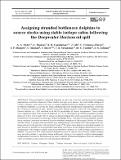Assigning stranded bottlenose dolphins to source stocks using stable isotope ratios following the Deepwater Horizon oil spill
Abstract
The potential for stranded dolphins to serve as a tool for monitoring free-ranging populations would be enhanced if their stocks of origin were known. We used stable isotopes of carbon, nitrogen, and sulfur from skin to assign stranded bottlenose dolphins Tursiops truncatus to different habitats, as a proxy for stocks (demographically independent populations), following the Deepwater Horizon oil spill. Model results from biopsy samples collected from dolphins from known habitats (n = 205) resulted in an 80.5% probability of correct assignment. These results were applied to data from stranded dolphins (n = 217), resulting in predicted assignment probabilities of 0.473, 0.172, and 0.355 to Estuarine, Barrier Island (BI), and Coastal stocks, respectively. Differences were found west and east of the Mississippi River, with more Coastal dolphins stranding in western Louisiana and more Estuarine dolphins stranding in Mississippi. Within the Estuarine East Stock, 2 groups were identified, one predominantly associated with Mississippi and Alabama estuaries and another with western Florida. δ15N values were higher in stranded samples for both Estuarine and BI stocks, potentially indicating nutritional stress. High probabilities of correct assignment of the biopsy samples indicate predictable variation in stable isotopes and fidelity to habitat. The power of δ34S to discriminate habitats relative to salinity was essential. Stable isotopes may provide guidance regarding where additional testing is warranted to confirm demographic independence and aid in determining the source habitat of stranded dolphins, thus increasing the value of biological data collected from stranded individuals.
Citation
Hohn , A A , Thomas , L , Carmichael , R H , Litz , J , Clemons-Chevis , C , Shippee , S F , Sinclair , C , Smith , S , Speakman , T R , Tumlin , M C & Zolman , E S 2017 , ' Assigning stranded bottlenose dolphins to source stocks using stable isotope ratios following the Deepwater Horizon oil spill ' , Endangered Species Research , vol. 33 , pp. 235-252 . https://doi.org/10.3354/esr00783
Publication
Endangered Species Research
Status
Peer reviewed
ISSN
1863-5407Type
Journal article
Collections
Items in the St Andrews Research Repository are protected by copyright, with all rights reserved, unless otherwise indicated.

